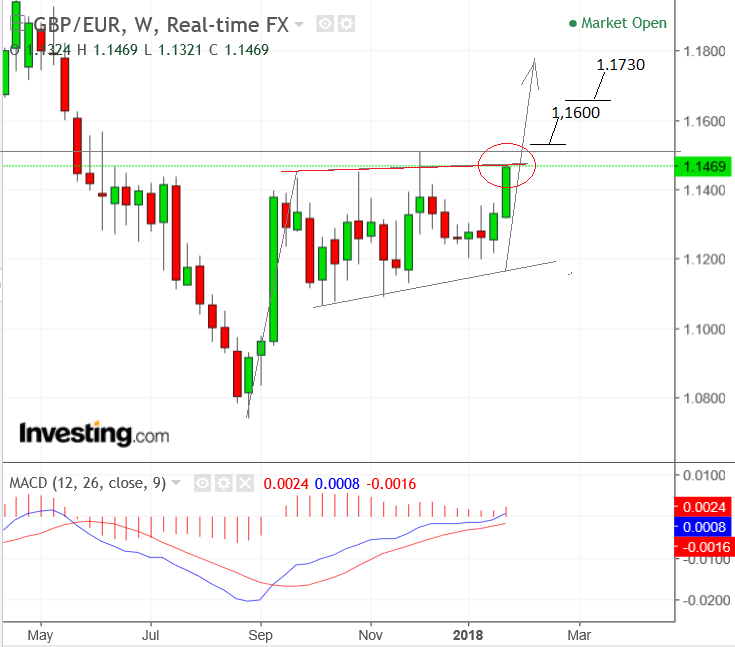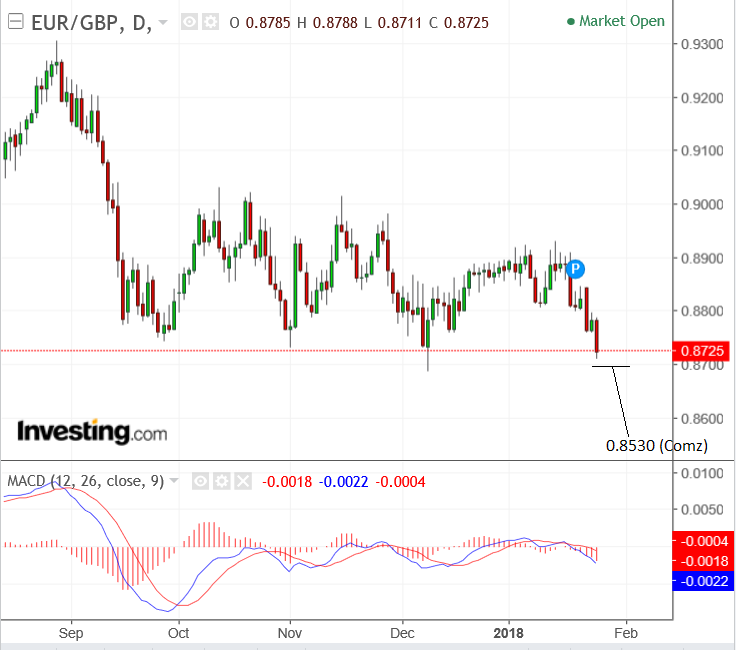Pound vs. Euro Surge Reaches a Key 'Make or Break' Level

The Pound-to-Euro exchange rate has been range bound for some time, but it could be about to break out into higher levels.
The GBP/EUR exchange rate has risen sharply over the course of the past 24 hours and finds itself at 1.1457 having gone as high as 1.1493 at one point earlier in the day.
The exchange rate opened the day at 1.1383, the strength of the move confirms the UK currency currently enjoys positive momentum and on this basis we would expect further advances.
The advance has come about partly as a result of better-than-expected UK employment data which showed wages increasing by a higher 2.4% than the 2.3% analysts had predicted.
Higher wages are likely to lead to higher inflation and higher interest rates, which have a market influence on the Pound.
Higher interest rates tend to drive up the Pound as they attract greater flows from foreign investors seeking somewhere profitable to park their money.
The subsequent rally in Sterling has led to a rise up within the range the pair has been in for the last six months, roughly between 1.1100 and 1.1500.

Our week-ahead forecast correctly predicted the rise although the upside target at 1.1500 at the top of the range has yet to be reached.
But, now we are at a key level where we expect the rally to find extra vigour, or capitulate as it has done so many times over recent months.
The top of the range is a 'make or break' level which the exchange rate will struggle to break above because many short-term traders could be anticipating a pull-back and act accordingly by selling the Pound at that level, thus contributing to the downside pressure through their own actions.
A such we would want to see a break above the December 8 highs at 1.1510 for decisive confirmation that the upper border of the consolidation had been breached.
Assuming such a break the pair would be expected to rally up to an initial target at 1.1600 followed by 1.1730, as per our week ahead forecast.
"A subsequent move above the wave 'd', December 8, highs at 1.1510 would confirm a breakout to the upside, to an initial target at 1.1600, just below the R2 monthly pivot," we said in our earlier forecast.
The R2 at 1.1603 is likely to restrain upside because monthly pivots tend to exert downward pressure on rising prices due to traders targeting them as levels to short-sell.
A clear break above R2, however, confirmed by a move above 1.1630 would signal a continuation up to a final target at 1.1730, calculated by taking the 61.8% of the height of the range and extrapolating it higher - a tried and tested method for establishing a minimum target after a breakout.
61.8% is related to the 'golden mean' - a mathematical ratio of 0.618 which has been found to govern proportional relationships in many natural phenomena from the distribution of sunflower seeds to the whorl on sea snail shells - and reputedly waves of buying and selling in financial markets too.
Flipping the chart over and looking at it from the Euro's perspective (EUR/GBP) gives an inverted view of the same price action which suggests the Euro has further to fall.
In her analysis of EUR/GBP, Commerzbank Analyst Karen Jones, is increasingly bearish (which means bullish GBP/EUR), saying, "EUR/GBP remains under pressure," and "the cross recently sold off to the 61.8% retracement of the move seen this year at 0.8697. A close below here targets the 0.8530/78.6% retracement of the move seen this year."
0.8530 in EUR/GBP gives us a GBP/EUR exchange rate target of 1.1723.

Get up to 5% more foreign exchange by using a specialist provider to get closer to the real market rate and avoid the gaping spreads charged by your bank when providing currency. Learn more here.
ECB Meeting will be Key
Whether or not Sterling is able to break into fresh air against the Euro will however largely depend on how Thursday's European Central Bank meeting goes.
Investors have bought Euros through the course of 2017 in anticipation of the day the ECB finally turns off its printing machines that have been pumping money into the Eurozone economy for a number of years now. To keep the Euro's rally alive they will want the ECB to confirm today that this intention remains intact.
This money printing - more formally known as the asset purchase programme - has kept the Euro suppressed, and expectations for its demise have boosted the Euro.
The only problem is that there is a distinct chance the ECB are now uncomfortable with the rise in value of the Euro as it makes Eurozone exports less competitive, and more importantly, creates downward pressure on inflation.
There is a distinct chance that the ECB push back against the rising Euro by 1) mentioning their discomfort with the exchange rate directly or 2) warning they will keep their asset purchase programme going for longer.
This will surely hurt the Euro and allow the Pound-to-Euro exchange rate a chance at piercing above 1.1510.
But, it's hard for the ECB to justify such as stance, after all the Eurozone economy is booming, as shown by yet another recent set of data which confirms growth is at its highest level for years.
This is simply not an economy that requires emergency assistance from he ECB. There is a real chance that should the ECB continue with this policy it risks creating another crisis later on down the line.
Therefore, the ECB's ability to push back against the Euro are limited.
If the markets get the sense that this is indeed the case, then we could well see the Euro pop higher and the Pound-to-Euro rate relegated back towards 1.13 and even 1.11.




